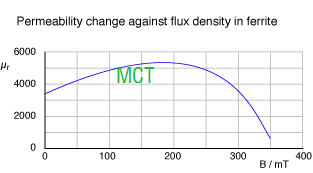In wound components the magnetic core plays a vital role in raising the level of magnetic flux produced by a given current flow in the windings. That is to say, it increases the inductance.
Unfortunately, the increase in flux provided by ferromagnetic materials is never a simple linear factor. At first, as the field strength is raised, the flux increase is a modest one. At higher currents the increase is more rapid, but at yet higher currents the flux increase slows again. Finally, saturation is reached and any further current increase generates but a minuscule increase in flux.
These changes in inductance with current are a nuisance at best. In high power transformers, however, saturation must be avoided at all costs because the ensuing drop in inductance leads to a sharp increase in magnetizing current, further core overload and a 'runaway' situation that often ends with smoke and flames :-(
Also, ferromagnetic materials all suffer from temperature dependance. In resonant circuits, for example, you normally prefer that the inductance remains constant with temperature and not detune the circuit as the environment changes.
In a high-Q tuned circuit you almost certainly want to run the core well below its saturation level - not through fear of flames but because you cannot afford to loose power to core hysteresis (which increases rapidly with B).
These three problems are usually alleviated by using a gapped core.

|
